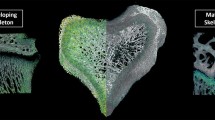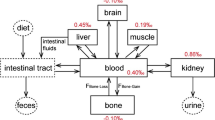Abstract
A genetically engineered “knockout gene” mouse model for human cystic fibrosis (CF) has been utilized to study bone mineralization. In CF, the so-called cystic fibrosis transmembrane conductance regulator (CFTR) protein, a chloride ion channel, is either absent or defective. To produce the animal model the murine CFTR gene has been inactivated producing CF symptoms in the homozygotic progeny. CF results in abnormal intestinal absorption of minerals and nutrients which presumably results in substandard bone mineralization. The objective of this study was to determine the feasibility of using whole-body thermal and fast neutron activation analysis to determine mineral and trace-element differences between homozygote controls (+/+) and CF (−/−), murine siblings. Gender-matched juvenile +/+ and −/− litter mates were lyophilized and placed in a BN capsule to reduce thermal-neutron activation and irradiated for 10 seconds at φfast ≈ 1·1013 n·cm−2·s−1 using the MURR pneumatic-tube facility. Phosphorus was measured via the31P15(n,α)28Al13 reaction. After several days decay, the whole-body specimens were re-irradiated in the same facility, but without thermal-neutron shielding, for 5 seconds and the gamma-ray spectrum was recorded at two different decay periods allowing measurement of77mSe,24Na,27Mg,38Cl,42K,49Ca,56Mn,66Cu and80Br from the corresponding radiative-capture reactions.
Similar content being viewed by others
References
C. Norvell, Current Health 2, 21(9) (1995) 22.
F. S. Collins, Science, 256 (1992) 774.
T. F. Boat, M. J. Welsh, A. L. Beaudet, Metabolic Basis of Inherited Disease,C. R. Scriver, A. L. Beaudet, W. S. Sly, D. Valle, J. B. Stansbury (Eds), McGraw-Hill Information Services Company, New York, NY, 1989, p. 2649.
M. J. Welsh, A. E. Smith, Sci. Am., 273(6) (1995) 52.
Progress in Cystic Fibrosis Research, Cystic Fibrosis Foundation, Nov., 1996.
J. N. Snouwaert, K. K. Brigman, A. M. Latour, N. N. Malouf, R. C. Boucher, O. Smithies, B. H. Koller, Science, 257 (1992) 1083.
L. L. Clarke, B. R. Grubb, S. E. Gabriel, O. Smithies, B. Koller, R. C. Boucher, Science 257 (1992) 1125.
L. L. Clarke, B. R. Grubb, J. R. Yankaskas, C. U. Cotten, A. Mckenzie, R. C. Boucher, Proc. Natl. Acad. Sci. USA, 91 (2) (1994) 479.
M. P. Anderson, D. N. Sheppard, H. A. Berger, M. J. Welsh, Science, 257 (1992) 1083.
L. K. Bachrach, C. W. Loutit, R. B. Moss, Am. J. Med., 96 (1994) 27.
F. Cua, Biol. Trace Elem. Res., 30 (1991) 277.
R. C. Henderdon, B. B. Specter, J. Pediatr., 125(2) (1994) 208.
Author information
Authors and Affiliations
Rights and permissions
About this article
Cite this article
Mason, M.M., Morris, J.S., Derenzy, B.A. et al. Whole body analysis of the knockout gene mouse model for cystic fibrosis using thermal and fast neutron activation analysis. J Radioanal Nucl Chem 236, 107–112 (1998). https://doi.org/10.1007/BF02386326
Received:
Issue Date:
DOI: https://doi.org/10.1007/BF02386326




